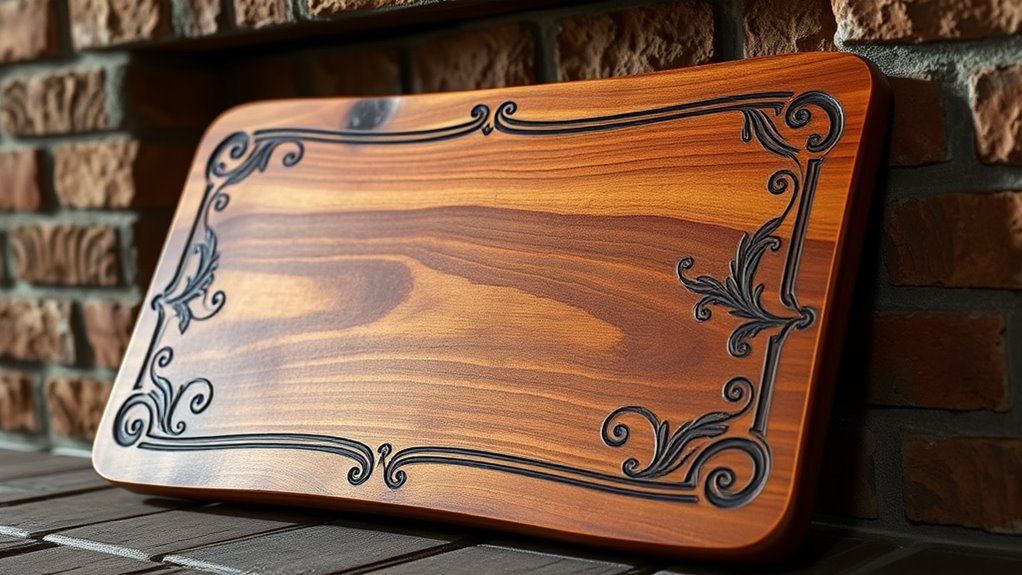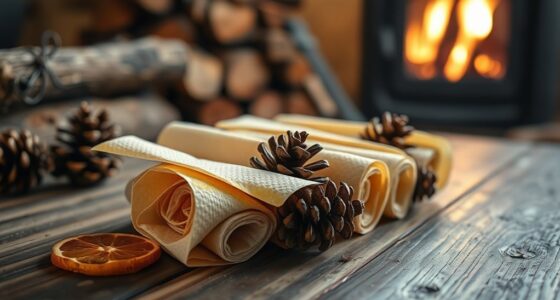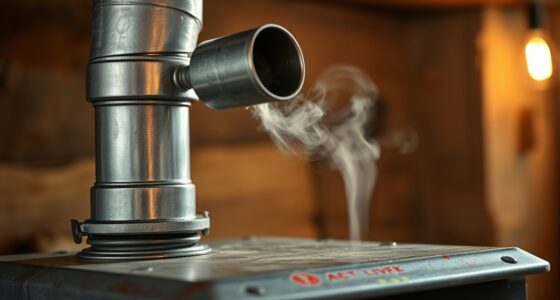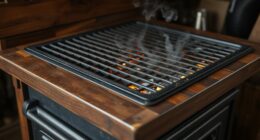To create a DIY decorative stove board that offers heat protection, start by measuring the space around your fireplace to guarantee a snug fit. Choose heat-resistant materials like cement board, fireproof drywall, or metal panels, and cut them to size using appropriate tools. Secure the board with heat-resistant adhesives or fasteners, then finish with heat-proof paint or decorative elements. For safe, stylish results, keep safety standards in mind—if you want detailed steps, continue exploring the process.
Key Takeaways
- Measure your fireplace area accurately to ensure a snug, safe fit for the stove board.
- Choose heat-resistant materials like cement board, fireproof drywall, or metal panels rated for fireplace use.
- Use appropriate tools such as a circular saw or metal shears, and wear safety gear during cutting.
- Secure the stove board with heat-resistant adhesives or fasteners designed for high temperatures.
- Finish with heat-resistant, non-toxic paint and regularly inspect for damage to maintain safety and appearance.
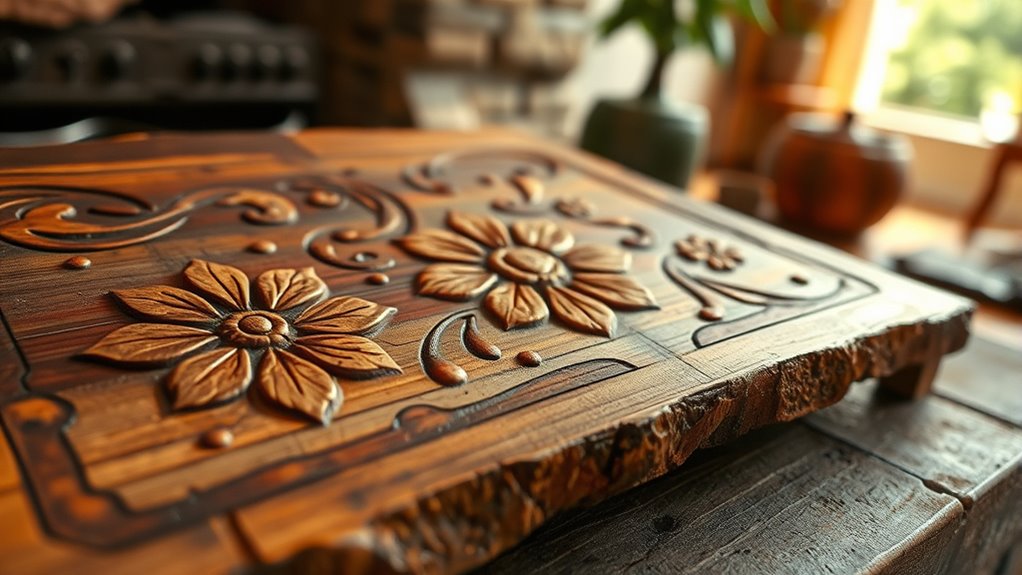
A decorative stove board can instantly elevate the look of your fireplace area, making it a stylish focal point in your home. Beyond aesthetics, it also plays a vital role in fireplace safety by protecting surrounding walls and furniture from heat damage. When you’re crafting your own stove board, it’s essential to prioritize heat resistant materials. These materials ensure that the board can withstand high temperatures without warping, cracking, or posing a fire hazard, giving you peace of mind while enjoying your fireplace.
A stylish, heat-resistant stove board enhances safety and elevates your fireplace’s look.
Choosing the right heat resistant materials is the first step. Common options include cement board, fireproof drywall, or metal panels designed specifically for high-temperature environments. Cement board, for example, is durable and easy to work with, providing excellent heat resistance. Metal panels, like stainless steel or powder-coated steel, are also popular since they resist heat and are simple to clean. Whatever material you select, make sure it’s rated for fireplace use and meets safety standards to support your fireplace safety goals effectively.
Once you’ve selected your materials, measure the space around your fireplace carefully. Precision matters here because your stove board should fit snugly without obstructing airflow or access. Cutting your materials to size might require specialized tools, such as a circular saw for cement board or metal shears for panels. Always wear safety gear, like gloves and goggles, and work in a well-ventilated area to avoid dust inhalation or injury. When cutting, keep your work surface stable and follow manufacturer instructions for your chosen materials.
As you assemble your DIY stove board, focus on securing it firmly in place. Use heat-resistant adhesives or fasteners designed for high-temperature environments. If your design includes decorative elements, consider adding them after ensuring the main board is securely installed for maximum safety. Painting or finishing your stove board with heat-resistant, non-toxic paints enhances its appearance and durability. Be sure to choose finishes that can withstand heat and won’t emit harmful fumes when exposed to high temperatures.
Throughout the process, never compromise on safety. Regularly check that your stove board remains securely installed and free of cracks or damage. Remember, a well-made DIY stove board not only enhances your fireplace’s style but also acts as a critical safety barrier. By selecting appropriate heat resistant materials and installing your board correctly, you create a beautiful, safe, and functional addition to your home. Proper planning and attention to fireplace safety details will ensure your project is both successful and long-lasting. It’s also helpful to understand fireplace safety standards to ensure your project complies with local building codes and safety regulations.
Frequently Asked Questions
What Safety Standards Should I Follow When Installing Stove Boards?
When installing stove boards, you should follow safety standards by using fire-resistant materials and guaranteeing proper clearance regulations are met. Make sure the board is made from non-combustible materials like metal or specific fire-resistant panels. Keep a safe distance between the stove and the board, usually outlined in local codes. Always check your local building codes and manufacturer instructions to ensure safe, compliant installation.
Can DIY Stove Boards Be Used With All Types of Stoves?
Think of DIY stove boards like a universal key, but not every lock is compatible. You can use them with many stove types, thanks to their material versatility. However, stove board compatibility varies, especially with electric, gas, or wood stoves. Always check manufacturer guidelines and guarantee your chosen material suits your stove’s heat output and design. This way, your DIY project remains safe, effective, and stylish.
How Do I Maintain and Clean My Decorative Stove Boards?
To keep your decorative stove boards looking great, regularly dust and wipe them with a soft cloth. Use gentle cleaning techniques, like mild soap and water, to prevent damaging the stove board finishes. Avoid abrasive cleaners or scrubbers. If your board has painted or sealed finishes, check manufacturer recommendations for cleaning. Regular maintenance ensures your stove board stays attractive and protected, enhancing your space’s style and safety.
Are There Eco-Friendly Materials Suitable for DIY Stove Boards?
Sure, eco-friendly materials exist for your DIY stove boards—because who doesn’t want to save the planet while pretending to be a crafts expert? You can use recycled materials like reclaimed wood or metal, and natural fibers such as cork or hemp, which are both sustainable and stylish. These options not only protect your walls but also make you feel good about reducing waste. Now, go ahead, be the green hero of your home!
What Is the Average Cost of Materials for a DIY Stove Board Project?
You can expect material costs for your DIY stove board project to range from $50 to $150, depending on the size, materials, and design choices. When budget planning, consider eco-friendly options like reclaimed wood or cork, which might be slightly more expensive but add durability and sustainability. Keep in mind that investing in quality materials guarantees better heat protection and longevity, helping you save money in the long run.
Conclusion
So, there you have it—your stylish, homemade stove boards are ready to protect your walls and impress your guests. Who knew that a little paint, some creativity, and a dash of DIY spirit could turn a simple safety feature into a stunning focal point? Now, every time you admire your handiwork, just remember: all those fancy store-bought options are probably feeling a little jealous. Sometimes, the best protection truly is homemade—and way more fun.

